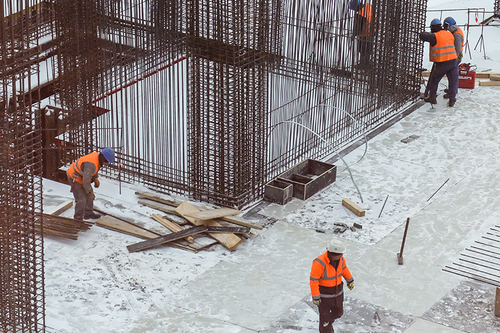Cold Weather Gear Checklist
If your work requires you to dress in extreme cold weather gear, you’re in luck, because there are many technological advances in cold weather work gear that can help keep you warm while performing at your best. Avoid cold-related illnesses and injuries by dressing in at least three layers of thin cold weather gear.
Base Layers
What you wear closest to your skin should be slightly loose, comfortable, and long enough to keep you covered. It should also vent in the underarms and dry quickly. Be sure to wear long-sleeved tops, like henleys, and long johns. Merino wool is a great wicking option, but a synthetic base layer is also good if you find wool itchy.
Mid Layers
Your middle clothing layer should provide insulation from the cold while creating pockets to trap body heat and warm air. It should be breathable in order to decrease moisture buildup from sweat and thin and light enough to move in easily. Synthetic fleece tops and pants are ideal, especially in wet weather.
Outer Layers
Your outer layer should be durable enough to stand up to the elements and keep out wind and rain while allowing air and moisture from your body to pass through. You can find hard and soft shell jackets and pants, which are good for wet and high-energy activities, respectively.
Head and Eye Protection
Your face and eyes are exposed to cold temperatures and related weather conditions, so you’ll want to protect them as well. At least one of your layers should have a hood, but a windproof hat made of wicking materials is a good addition. Consider balaclavas, thermal liners, and trapper hats.
Eyes are also vulnerable to the cold weather thanks to snow glare, eye strain, and foggy lenses. Safety glasses and goggles with polarized lenses can reduce eye strain and provide better visibility in snowy weather. Inherent anti-fog lenses enable workers to see clearly at all times, reducing injuries.
Footwear
Your footwear should also be insulated from the elements, but provide the extra benefit of traction in snowy and icy conditions. Try a breathable, thin cold weather sock that won’t restrict blood flow from inside your boots, or layer liner and wool socks. Winter boots should be water and windproof with high tops and an insulated upper. When looking at personal ice traction devices, consider carbon steel or tungsten carbide cleats, and think about whether you’ll need heel-only or easy on/off designs.
Cold Weather Gloves
The ideal gloves for working in the cold will keep your hands warm while making sure you keep the dexterity you need to do your work. Look for cold weather work gloves that have water-repellent finishes and membranes, dual-zone insulation, and can enable you to interact with mobile devices.
Cold Weather Gear From PK Safety
PK Safety carries a wide range of cold weather gear suited for any job. Dressing in layers of thinner cold weather gear is better than putting on a single gigantic coat, so make sure you’re dressed for your job. Supplement your gear with heat packs, like these ones from PIP that come in 40 pairs per box, if conditions are really bad and remember to stay hydrated. Hydration helps keep your body temperature regulated and keeps you performing well in cold conditions, and since you might not feel as thirsty in the cold, be extra-aware of your fluid intake.
PK Safety has been in the business of keeping workers safe, comfortable, and informed for 70 years. If you have any questions for one of our safety experts, send them to us online or call us at 800.829.9580.
Recent Posts
-
Customizing Gas Detectors: Tailoring Solutions to Fit Your Unique Requirements
In today’s diverse industrial landscape, a one-size-fits-all approach to safety simply doesn’t cu …Jul 3rd 2024 -
10 Ways to Prevent Wildfires
You can prevent wildfires by extinguishing flames before you leave the worksite. Avoid practicing …Jul 1st 2024 -
ANSI/ISEA 138 Safety Gloves: Ensuring Hand Protection
The human hand is an anatomical masterpiece and arguably the greatest tool attached to our bodies …Jun 25th 2024





